

WELCOME
Dear reader
Whatever your sport, there’s plenty to be done in these quieter months. Offshore is here to help you get on top of your boating to-do list and plan for the next season. Learn from one of our senior station technicians about winter maintenance (page 4). And from our All-weather Lifeboat Centre experts about ropes and rigging (page 14). On page 16, quiz yourself on one of the core skills from our boating checklists: what to do if you're solo sailing and suffer a head injury.
We’re feeling the cold this issue, with a look at how to minimise the risks of combining temperature extremes in sauna bathing (page 11) and how to protect kit from the elements (opposite). For escapism, head page 8 – where volunteers from Tighnabruaich RNLI share the magic of Argyll's Secret Coast with us.
dunnāco
dunnāco lee-morikū and the Offshore Team
Thank you to all who responded to our survey – you're helping shape the future of Offshore membership. We look forward to sharing more about this in a future issue. Email:
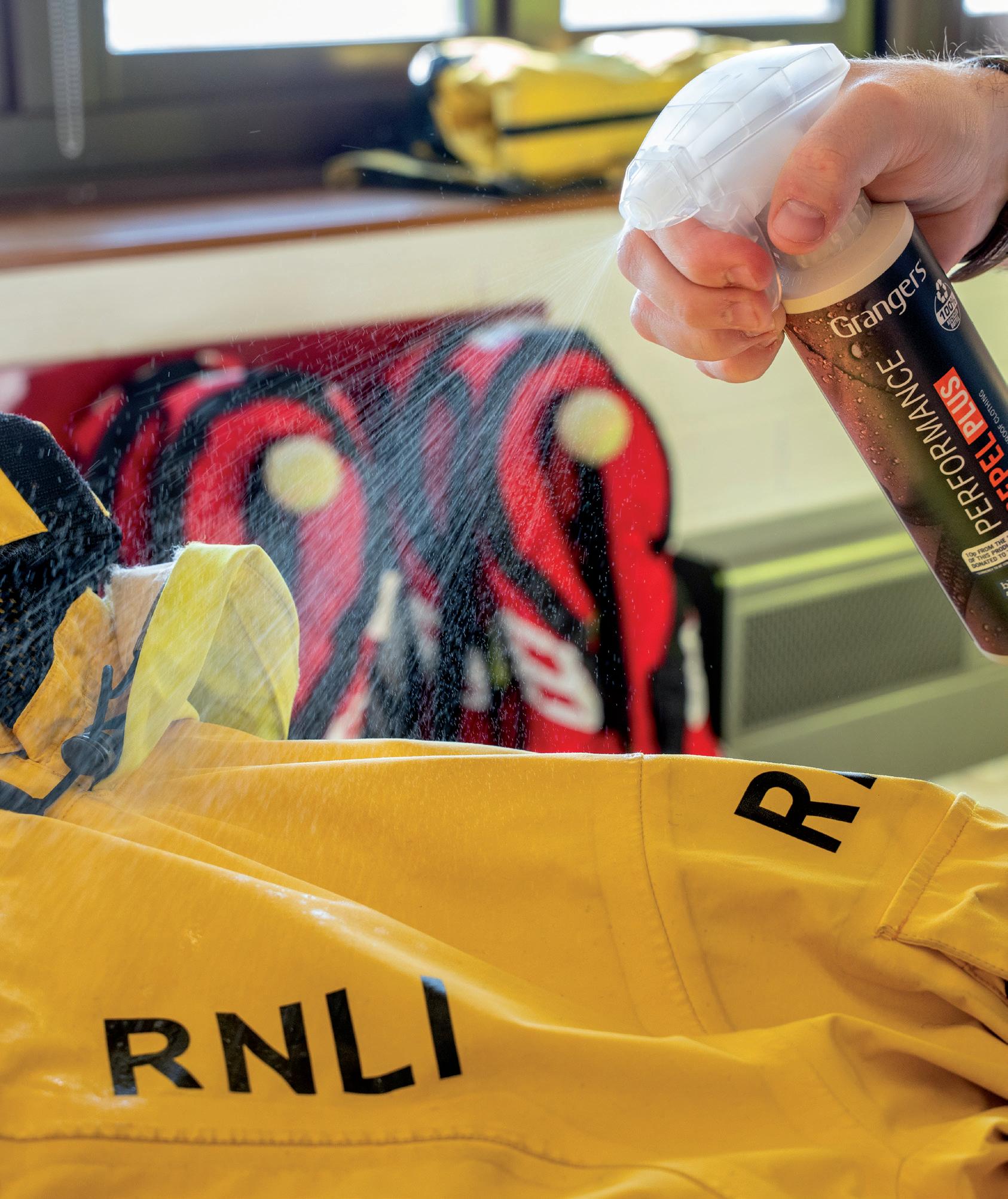
expressed by authors are not necessarily those of the publishers. Care is taken to ensure that editorial information is correct at the time of going to press but is subject to change.
CONTACT US
Executive: Peter Sparkes
Offshore Editor: dunnāco lee-morikū
Offshore Designer: Andy Perryman
Would you prefer to receive a digital copy of Offshore magazine or not receive it at all? Are you moving house? Do you have another question? Then please email supporterexperience@rnli.org.uk with your request, including your supporter number. You can also call us on 0300 300 9990 (from the UK), 01 511 9836 (from Ireland) or +44 1202 663234 (from any other country), or write to us at RNLI Support Centre, West Quay Road, Poole, Dorset, BH15 1HZ.
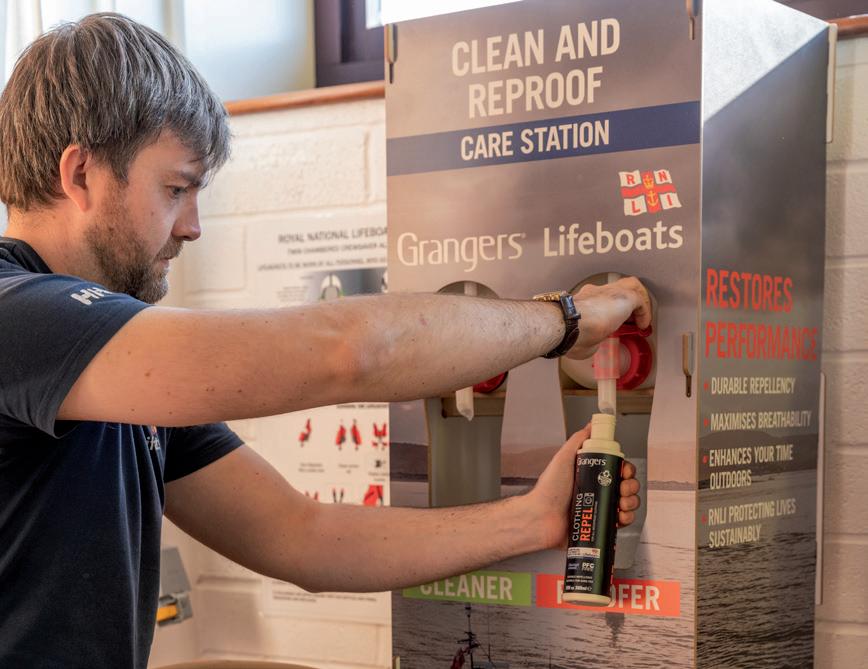
WINTER PICKS FROM THE RNLI SHOP
RNLI SINCE 1824 WELLY SOCKS, BLACK/ORANGE
Keep your feet warm and snug in the colder months with these cosy 'RNLI since 1824' ankle socks. Slightly thicker, they’re ideal for wearing with your wellies. Available in one size, UK adult 6–11.
RRP: £8/€10 Ref: RS2542401BORM0L


Photos: Grangers
ON THE RADAR:
PROTECTING CREW KIT
Raging storms, biting winds, driving rain – RNLI lifesavers brave the full force of the elements. So we’ve partnered with specialists Grangers to keep their kit ready to protect them when they need it most.
Grangers created the world’s first waterproofing solution in 1947 and has an impressive history of innovation in outdoor aftercare. The company is dedicated to protecting people from the elements, whether hill walkers or Everest climbers. And now it’s protecting RNLI lifeboat crews launching to the rescue whatever the conditions.
Two specialist Grangers products are being provided to our crews to look after the kit they rely on. Clothing Repel adds durable water repellency (DWR) to fabric – reducing wear and keeping it fit for use for longer. Performance Wash removes dirt and grime while preserving the DWR coating that keeps them dry. Like all Grangers products, they're free of perfluorinated compounds (PFCs) and are bluesign® approved.
Working in partnership is critical in our mission to save every one and our partners step up in many different ways to help us.
You can read more about this vital work at RNLI.org/partners.
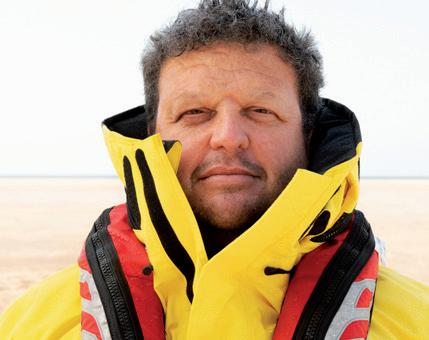
'They're easy to use, and ensure our kit is kept in top condition so that it can protect us from whatever weather we may face'
Grangers is providing care stations with its Clothing Repel and Performance Wash products for lifeboat crews to maintain their kit
LIFESYSTEMS RECHARGEABLE HAND WARMER
Up to 6 hours of heat, with 4 heat settings (40–50°C) from dual heat plates for warmth from both sides. Mains or USB chargeable, the hand warmer also doubles as a convenient power bank for USB-chargeable devices.
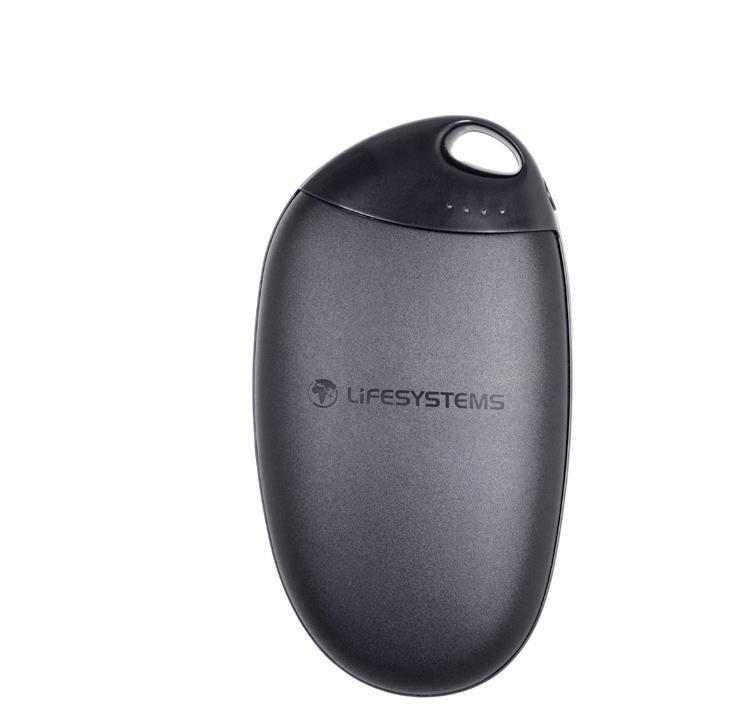
In this issue of Offshore, quotes, practical advice and lifesaving tips are brought to you by:

PAUL GEORGE
RNLI CELL LEADER (TRIALS AND COMMISSIONING)
Paul and his team run sea trials for lifeboats at the All-weather Lifeboat Centre. He has a background in rigging.
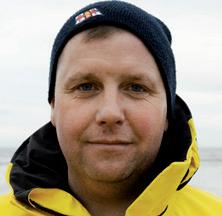
BARRY SHARKEY
SENIOR STATION TECHNICIAN, CLOGHERHEAD RNLI
Barry’s the person to speak to about all things Shannon. He keeps Clogherhead’s lifeboat safe and ready to save lives.

MIKE TIPTON
PROFESSOR OF HUMAN AND APPLIED PHYSIOLOGY, UNIVERSITY OF PORTSMOUTH
RNLI Council member Mike is a leading expert in cold-water survival, based out of the Extreme Environments Laboratory.
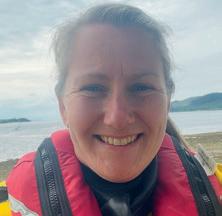
HEATHER WHYTE
LIFEBOAT TRAINER AND ASSESSOR AND HELM, TIGHNABRUAICH RNLI
Heather commands Tighnabruaich’s inshore lifeboat, keeping her crew safe as they save lives. She’s also a keen angler and boater.
RNLI LED BEANIE, BLACK
A warm and comfortable knitted beanie featuring the 'RNLI since 1824' branding. With a convenient LED light that’s removable for washing. 2x CR2032 batteries included.
RRP: £10/€12
Ref: RS2142110BLK



Howard Owen | Coxswain, Hoylake RNLI
WINTER WATCH-OUTS
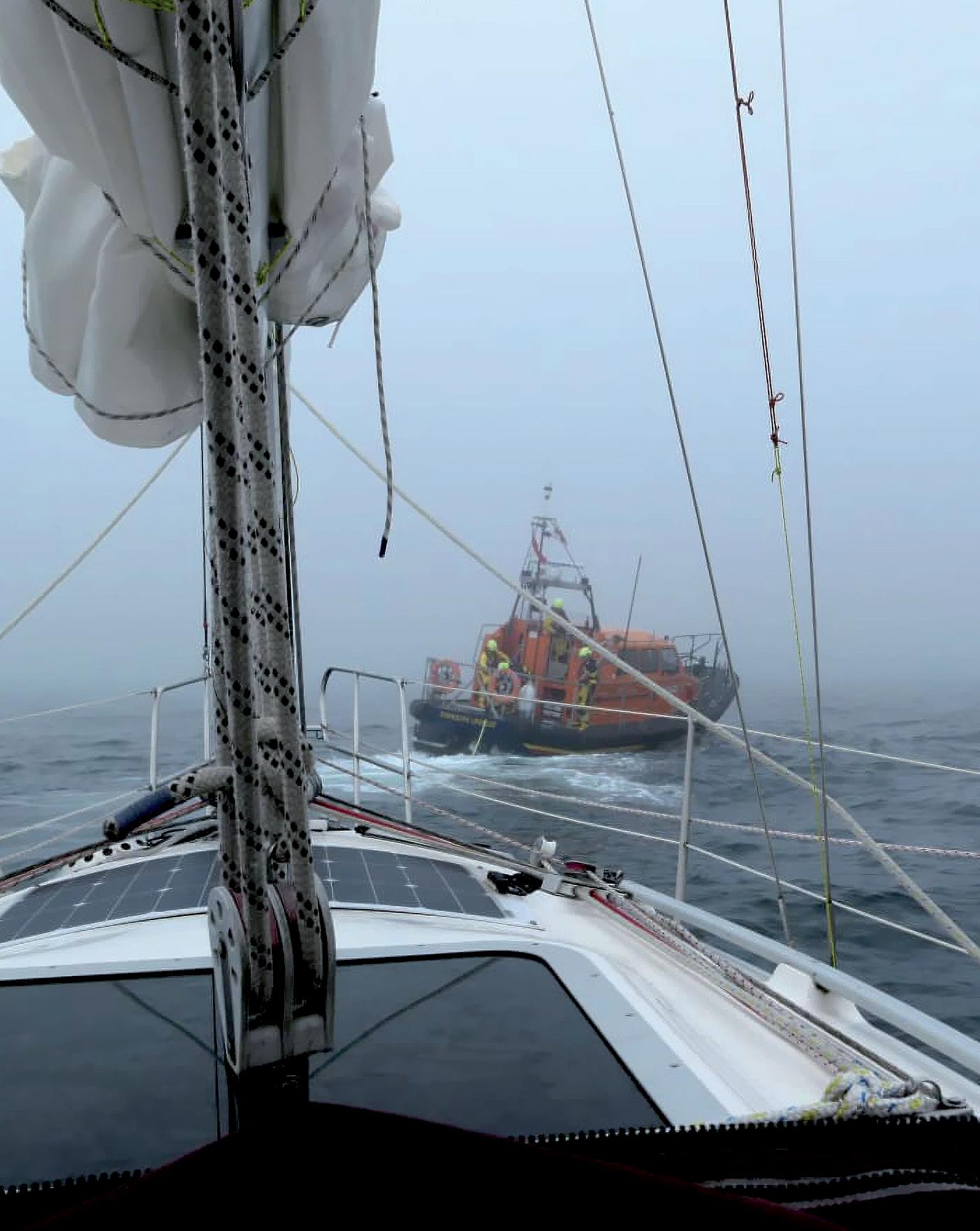
Tips
'Take care of your boat and it will take care of you'
' Machinery or equipment failure is the single biggest cause of RNLI call outs to sailing vessels and motorboats’

BARRY SHARKEY SENIOR STATION TECHNICIAN, CLOGHERHEAD RNLI
I’m a senior station technician looking after Clogherhead’s Shannon class all-weather lifeboat. I’d say the key thing to remember when you own a boat is that the best maintenance you can carry out is preventative maintenance.
We carry out bi-weekly, monthly and 6-monthly checks on the Shannon. We check things like the oil level, battery and electrics. We check belts and hoses for cuts, splits or fraying, and we look out for oil or coolant leaks. We check filters, and replace them when necessary.
It’s good practice to get into the habit of keeping a written record of all the maintenance you carry out, like RNLI technicians do. And when changing, say, an air filter, a good tip is to write the date on the part itself. That way, you’ll know when it’s time to change it again.
One of the best bits of advice I can give is to run your engine after any work carried out. Try to run it for at least an hour – the longer the better – to give any gremlins time to show themselves! If there is a problem, far better to realise that when docked up than out on the open sea.
'Around 60% of mechanical failures we see are due to fuel issues’

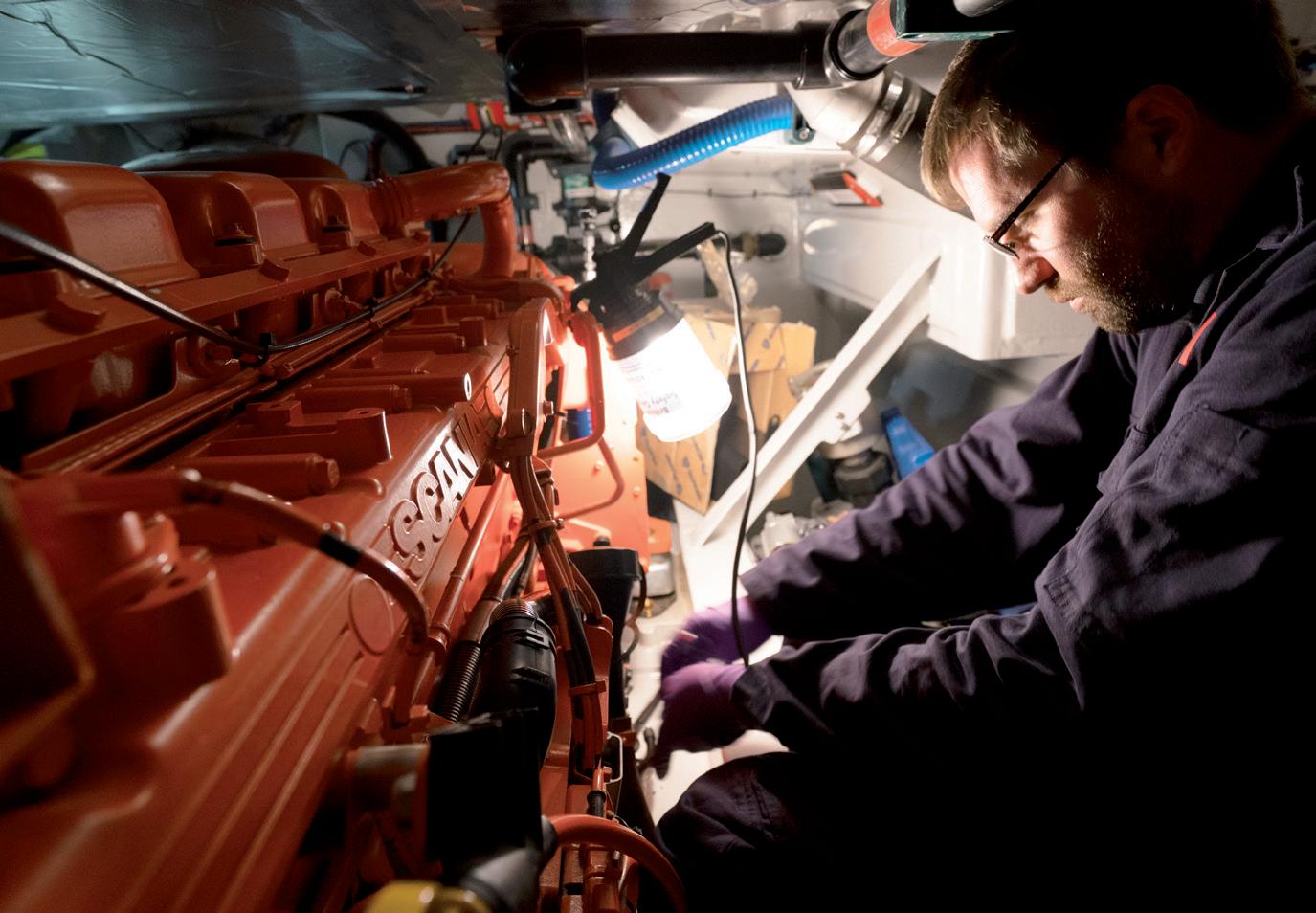

LOOK AND LEARN
If certain maintenance or repairs are beyond your capabilities, try to observe the work being done – if possible – so you can understand the workings of your boat better. Carry spares – you can never have too many! We keep a multitude onboard: things like oil filters, hydraulic filters, pipe-repair kits and spare alternator belts. And if possible, go afloat with others who know your boat or at least have some mechanical experience. Three heads are better than one.
In winter, it’s even more important to check coolant levels (pipes can freeze up in the colder months) and the alternator.
If you have a digital multimeter, use it to check the voltage – when the engine is running, you should see an increase. If you don’t, your system isn’t charging properly.
DON’T LET TROUBLE BREW
Spring and summer are when we tend to get more RNLI call outs, when boats are going afloat for the first time after sitting idle. During the winter months at the station, we use block heaters to keep the Shannon warm. If that’s not an option for you, run the engine every now and then, as this helps the electrics too. And it’s worth remembering that fuel goes off eventually, so changing it might prevent
An RNLI coxsain in the engine room of a Shannon class lifeboat
Keep a written record of all maintenance carried out

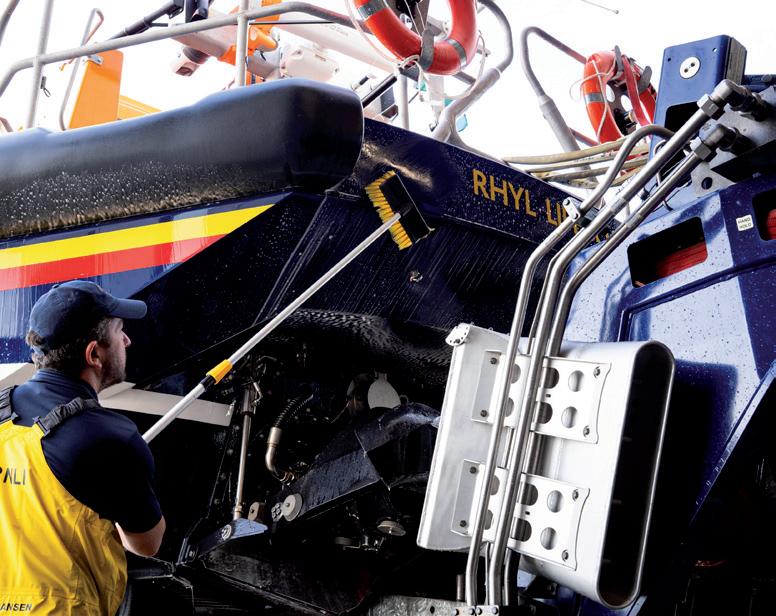

problems – around 60% of mechanical failures we see on casualty vessels are due to fuel issues.
Another bit of advice I’d give is that if you have a twin-engined boat, like our Shannon, make sure you know how to cross over your fuel and charging systems, so you can get home on one engine, or fuel tank, if necessary. It’s a great option to have, but futile if you don’t know how to switch over.
Lastly, remember that maintenance goes beyond the boat itself, and things can perish. We check our lifejackets every week. And every 6 months we inflate them for an hour. If yours has a light, check it’s working (it should show an expiry date). Out in the cold water is not the time to find out that your lifejacket doesn’t work.
FIND OUT MORE
Download our engine checklists at RNLI.org/boating, where you’ll also find a link to the RYA’s diesel engine maintenance course.
TOP TIPS
Check your engine
Machinery or equipment failure is the single biggest cause of RNLI call outs to sailing vessels and motorboats (almost 50%). Knowing your boat, carrying spares and being able to fit them increases your chances of being able to help yourself.
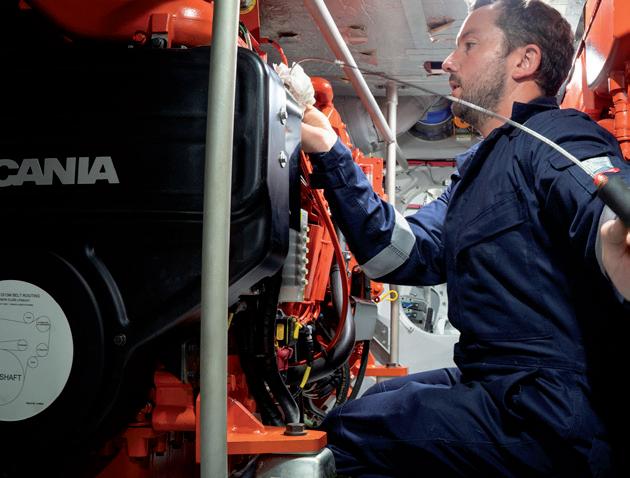
Check your lifejackets
Simple, regular checks and a professional annual service will ensure your lifejacket does what it’s supposed to, should you need it. To view a video about how to properly check and maintain it, visit RNLI.org/boating
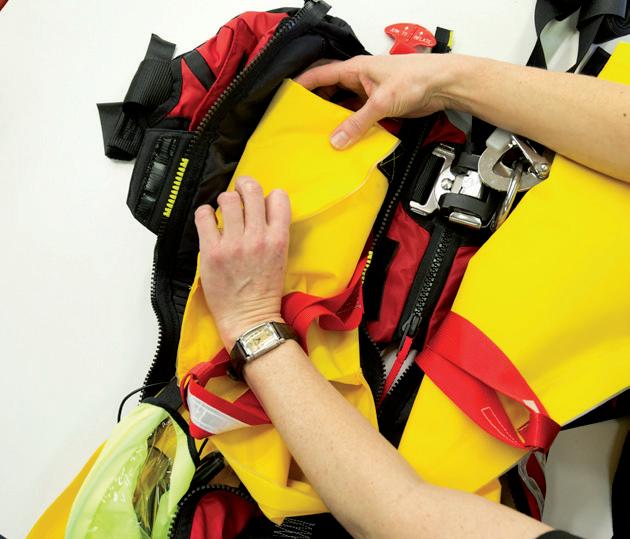
Upskill
For recreational boaters looking for courses and qualifications, the best places to start are the RYA (Royal Yachting Association) in the UK, and Irish Sailing in Ireland. Visit RYA.org.uk or sailing.ie. The RYA’s diesel engine maintenance course will help you to look after your engine and avoid problems when you’re at sea, for example.
After each launch, RNLI lifeboats are hosed down to help keep them in optimum condition
A technician at work in the RNLI’s All-weather Lifeboat Centre
Consider breakdown cover
For added peace of mind, consider taking out marine breakdown cover.
Check the weather and tides
Before you set off, check the weather forecast and sea state. If you’re planning to be out for any length of time, seek regular updates. And if conditions seem unfavourable, be prepared to change your plans or cancel your trip.

Plan ahead
Ensure that there’s an emergency action plan, and that everybody receives an onboard briefing (include where to find safety equipment and how to use it, such as the spare killcord for powerboats).
Know how to call for help
Even after due preparation, it’s easy to get caught out. Don’t rely on a single device for calling for help. There is a range available – VHF radio, personal locator beacons (PLBs) and emergency position indicating radio beacons (EPIRBs), for example. Whatever you rely on, make sure everyone onboard knows how to use it.
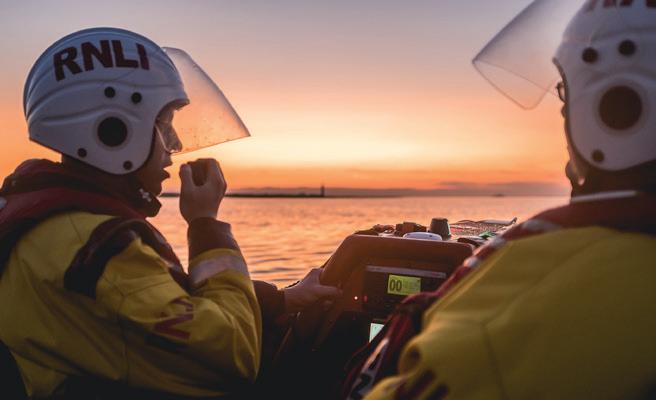
CASE STUDY: YACHT SUFFERS ENGINE FAILURE
AND DRIFTS TOWARDS SHORE
Alerted by HM Coastguard, the volunteer crew of Largs RNLI hurried to their lifeboat station in the Firth of Clyde, on Scotland’s west coast. On arrival, the crew learned that a sailor had issued a pan pan – the internationally recognised signal used when a situation is serious but does not pose an immediate danger to life, or the vessel. However, a pan pan does indicate a need for urgent intervention, to prevent the situation developing into something more serious.
While the Coastguard was working to pinpoint the yacht’s location, the Largs crew were asked to launch and head in the direction of Kip Marina. En route, the yacht’s updated position came through from the Coastguard, who’d heard from the yacht’s skipper via VHF radio.
Arriving on scene, the Largs volunteers found the vessel drifting to the shore and, due to the danger of the yacht running aground, it was decided that the safest option would be to tow it into the marina.
Once inside the marina, the yacht was safely tied up alongside a berth. With thanks from the Coastguard and the yacht’s owner, the volunteer crew

' It’s important to do daily
engine checks on your vessel prior to leaving any marina or harbour.
I like
to use the
mnemonic ‘WOBBLED’ – Water, Oil, Belts, Bilges, Leaks, Electrics and Diesel’
returned to their station, where the lifeboat was washed down, refuelled and made ready for the next call out.
RNLI Helm Angus Fergusson says: 'As a skipper, it’s important to know when and how to send a pan pan broadcast. In this case of a yacht suffering from engine failure and drifting, the correct choice of alert was used.' ■
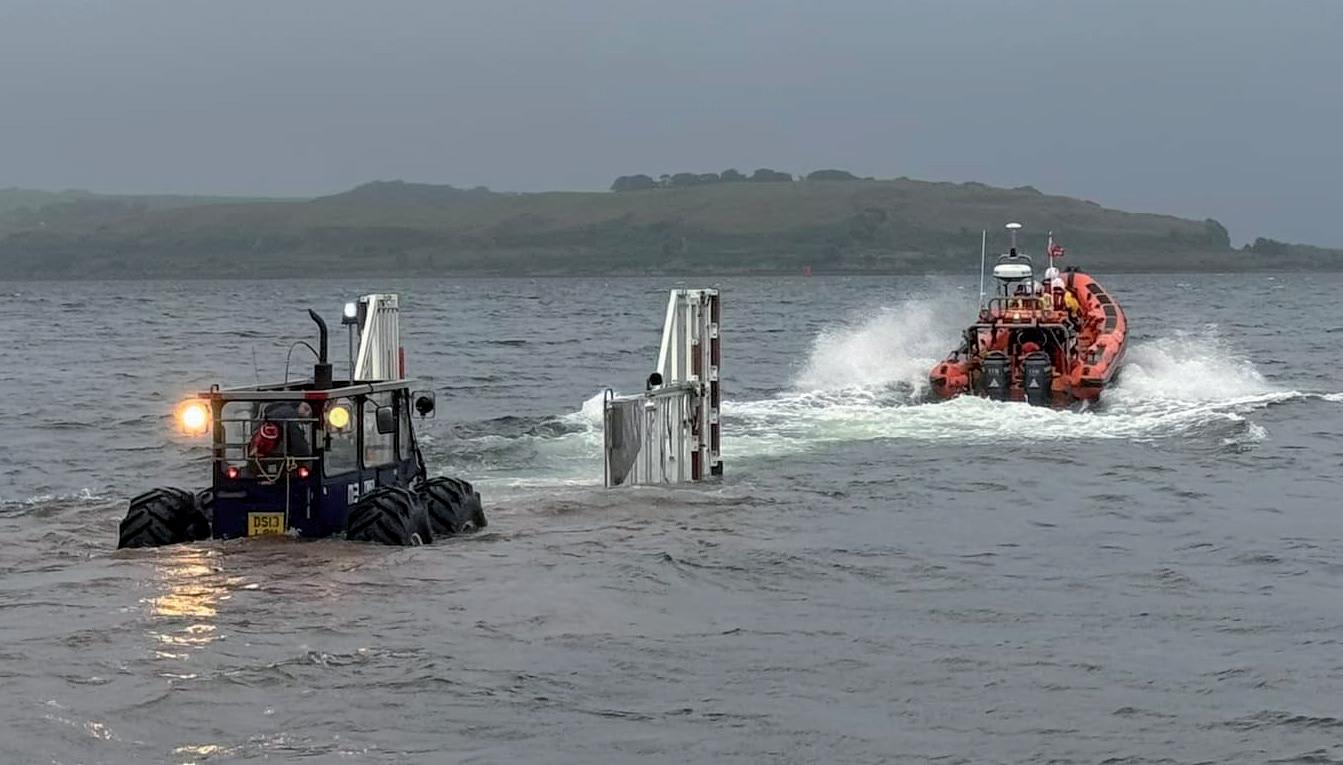
Angus Fergusson
Photos: RNLI/(Callum Robinson, Nathan Williams, Nick Mailer, Nigel Millard)
Angus Fergusson | Helm, Largs RNLI
Love where you live ...
ARGYLL’S SECRET COAST
Wend your way through the Kyles of Bute all the way to Loch Fyne
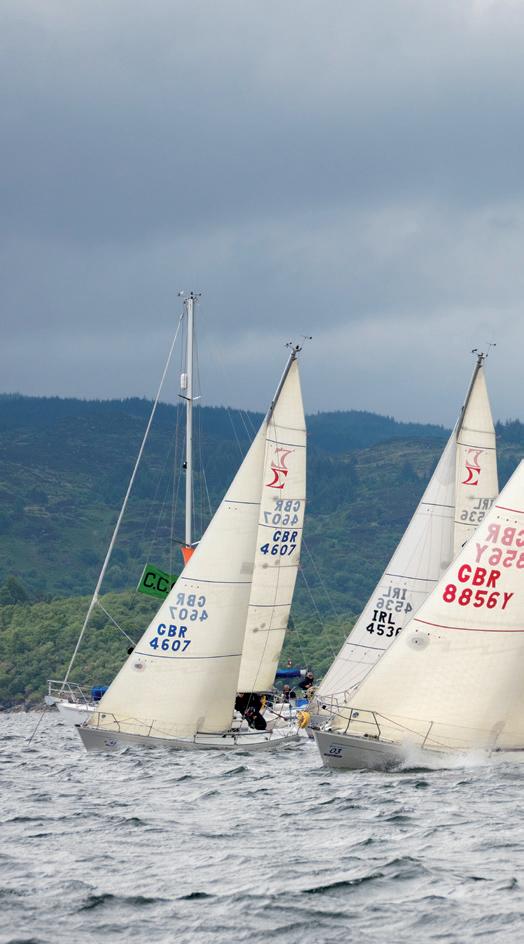

BEAUTIFUL, PEACEFUL AND FULL OF CHARACTER
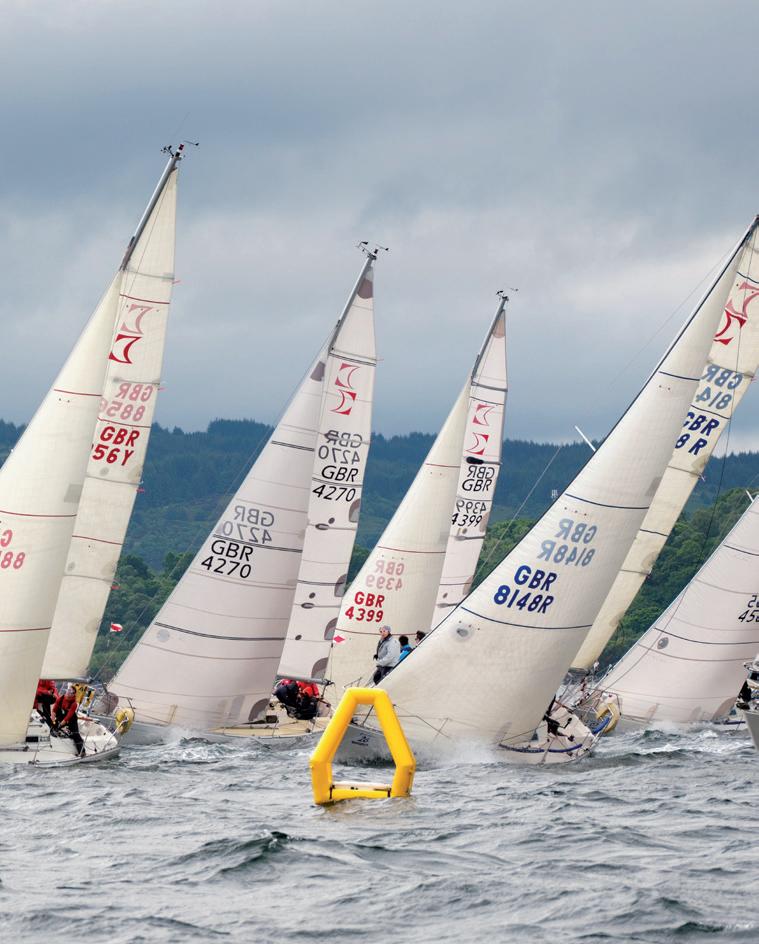

HEATHER WHYTE VOLUNTEER HELM, TIGHNABRUAICH RNLI

I was a Glasgow city girl, but I married a Tighnabruaich boy. I would never have dreamed of staying in a small village like Tighnabruaich, but I fell in love with the place. It’s got such a sense of community and it’s stunning.
We love going out fishing on a wee boat with our two kids. We’re only across the Clyde, not far from Glasgow, but it’s a different world. Swimming is very popular and you get a lot of kayakers coming round Bute. There are also paddleboarders and jet skiers. There’s a floating jetty just off the Tighnabruaich Lifeboat Station.
There are some wonderful and quirky restaurants in the area. Of course there are the oysters at Loch Fyne, but I recommend a great little restaurant here in Tighnabruaich called Tide and Thyme. You can do lovely walks around here and there are so many places to explore. There’s a great walk on the north end of the Isle of Bute, with an old war bunker and a tree swing. And we’ve got an absolutely stunning sandy beach at Ostel Bay. We like to go to Inveraray with the kids, at the top of Loch Fyne –it’s got the jail and the castle.
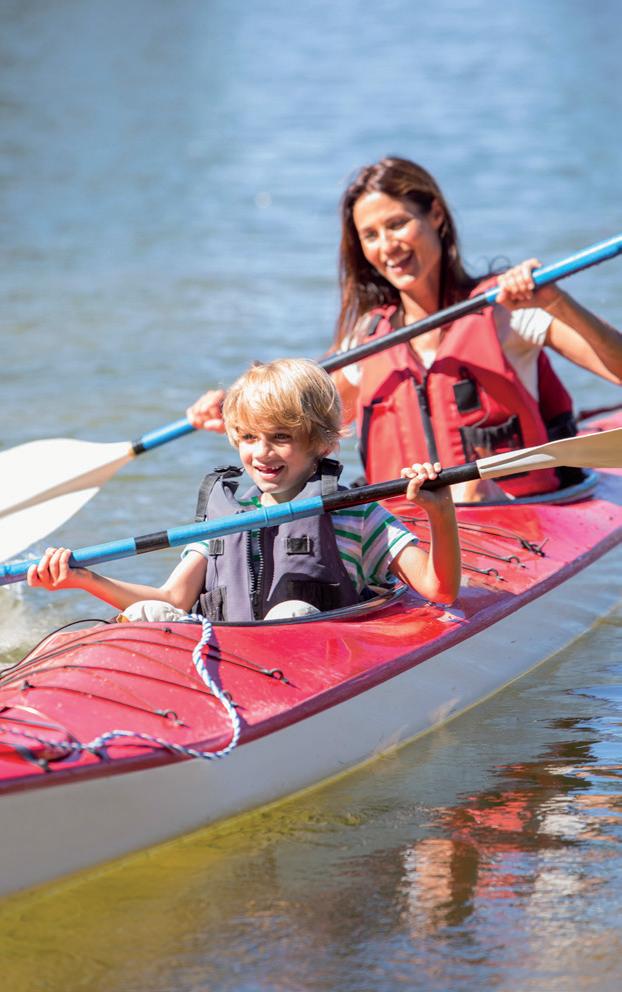
' We're not far from Glasgow, but it's a different world' The sheltered waters of the Kyles are popular with kayakers
The area’s great for wildlife. Plenty of porpoises and dolphins, seals, even basking sharks. In these unique waters stretching out into open waters, you never know what you’ll see.
The tide isn’t much of a bother to us here, but we get quite a few call outs to the Otter Ferry Spit. It can be really deceiving how shallow it is –even at high tide.
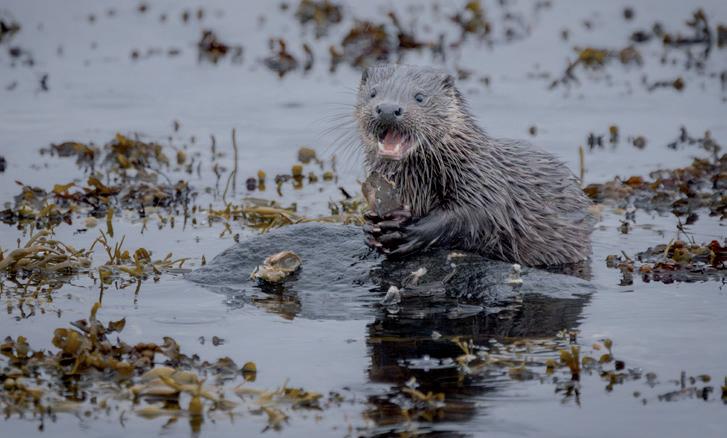


Tight racing at the Scottish Series
The Kyles of Bute viewpoint
The village of Tighnabruaich is the home of the local lifeboat station
Otters can often be spotted along the seafront in the mornings
Picture perfect: the view from Tighnabruaich Pier
LOVE WHERE YOU LIVE
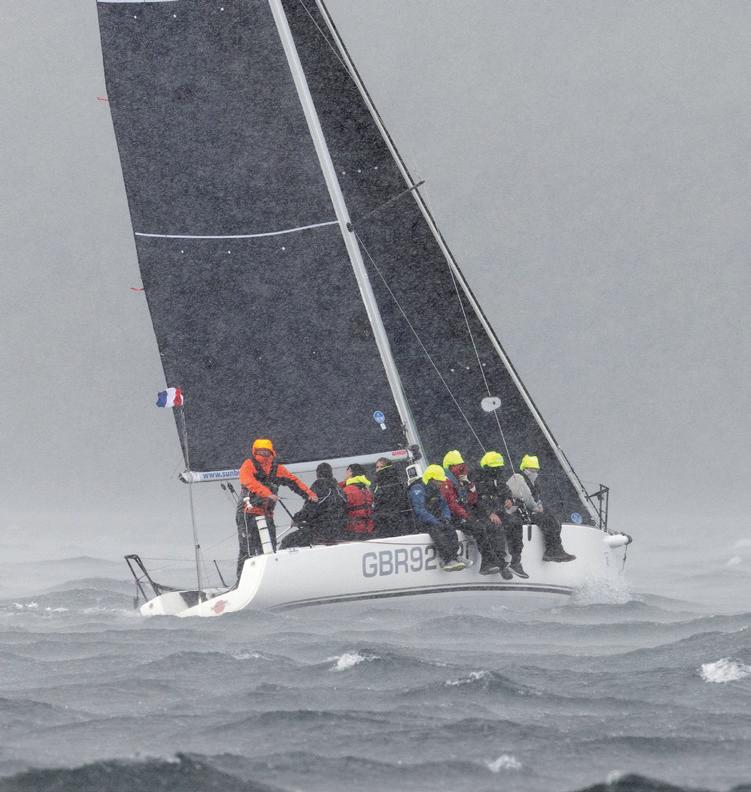
ALASTAIR TORBET
RNLI

I'm the fourth generation of my family to come from Tighnabruaich and I've sailed my entire life.
From out of my window, I can see right across the Kyles down to Bute. For me, it’s the best view in the world. To cap it all, last night we had the Waverley – the last seagoing paddle steamer in the world – coming right past us.
Portavadie on the shores of Loch Fyne has something for everybody. It’s a good starting point for walks, with lots of bays to discover. Take your wellies! From Portavadie you can take the ferry to Tarbert – an old fishing village.
'For me, it’s the best view in the world'
Sailing is popular here and there are a number of scenic, sheltered anchorages. There’s a very tranquil place called Caladh. And then there's Wreck Bay round by the Burnt Islands.
I was senior instructor at the local sailing school and we have some of the safest sailing waters in the west of Scotland – as secure as it can be. I’ve noticed there’s an increasing number of powerboats going far too fast around here.
For sailors, the most troublesome area potentially is Ardlamont, round
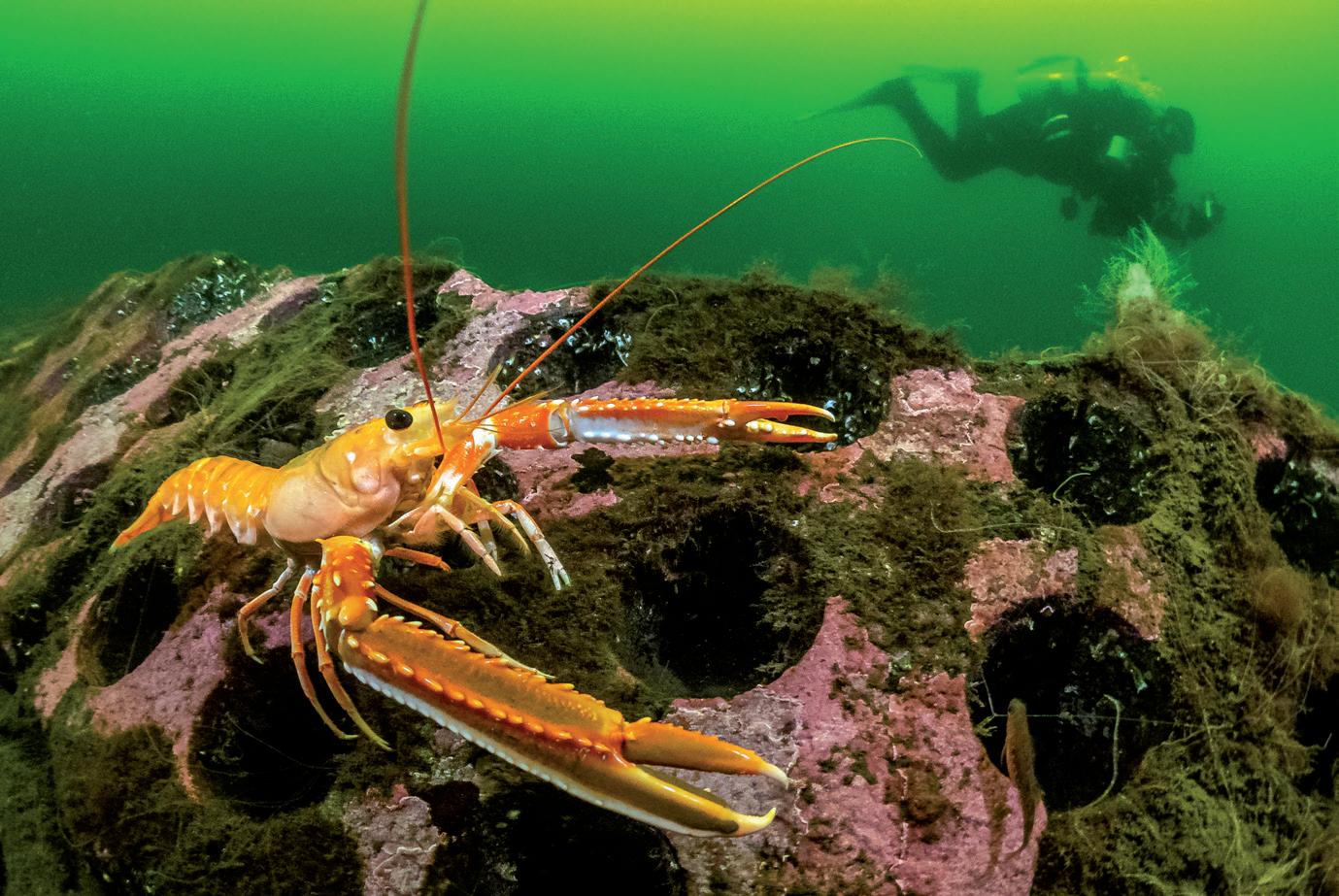
FYNE DIVING
There’s more to Loch Fyne than seafood and fine dining. It’s also a great location for scuba divers. It’s the longest sea loch in Scotland, stretching over 40 miles from the Sound of Bute. Visibility is (usually!) good in the sheltered waters and it’s teaming with marine life. Look out for the langoustine and the firework anemones!

the corner up to Loch Fyne. In stronger winds, it can be a bit unpleasant. We’ve already had a few call outs there this year.
If you’re into your yacht racing, we have the Scottish Series here, usually in May, with thousands of people involved and watching from the shores of Loch Fyne.
FIND OUT MORE
• wildaboutargyll.co.uk
• scottishseries.co.uk
• waverleyexcursions.co.uk
• facebook.com/tideandthymebistro ■
Words: Bethany Hope
Photos: Dan Bolt, Paul Paterson Press Photography, Shutterstock.com, Alastair Torbet, Andrew Wallace Photography, Heather Whyte
Take a cruise on the paddle steamer Waverley
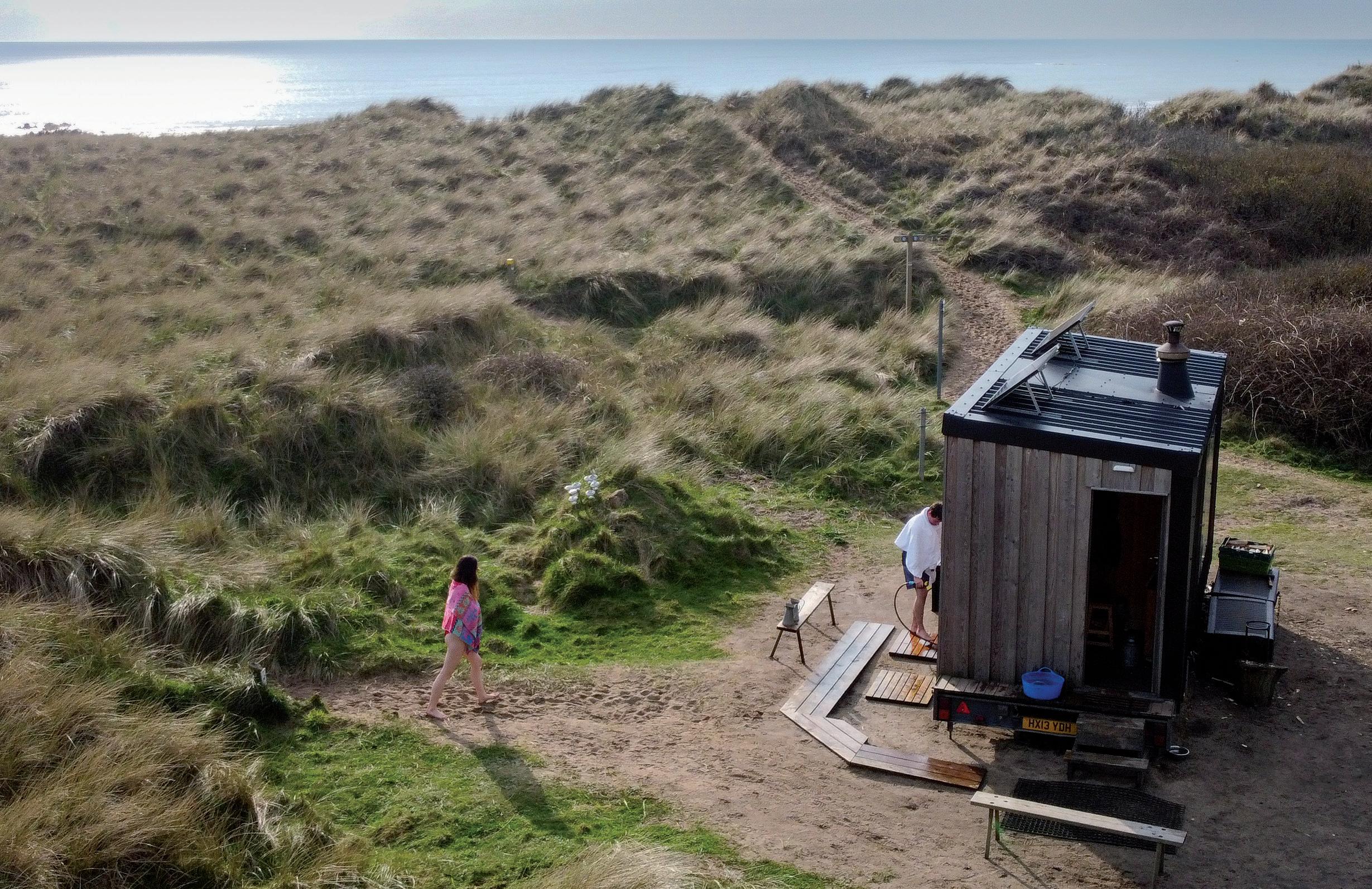
SAFER SAUNA BATHING
The UK and Ireland are seeing an evolution in sauna bathing, with a rapid rise in popularity. But what are the risks – and how can we reduce them?
The Nordic cultural tradition of sauna bathing – alternating between heating and cooling the body – has spread further afield in recent years, with outdoor saunas popping up in many scenic spots. This coincides with a boom in British Sauna Society registrations by sauna operators. Many people associate sauna bathing with wellbeing yet, as well as the usual dangers of open water, there are physiological risks. Both saunas and cold-water dips apply significant stress to our bodies. For dipping, the major physiological risks are cold water shock and cold-induced cardiovascular events. With saunas, dizziness and fainting are most commonly seen. So what happens when we combine the two?
Our Water Safety Team is working with Professor Mike Tipton of the Extreme Environments Laboratory at the University of Portsmouth to understand the science.
IT’S IN THE BLOOD
Mike says: 'There's a common misconception that cold water shock is more extreme when dipping after sauna, but there's little evidence of this. What we do know is that acclimatising to each extreme slowly is vital. With dipping then sauna, the pre-cooling of body temperature can lead to people spending longer in a sauna before reaching the point they feel they must exit – so they can lose more fluids through sweating.
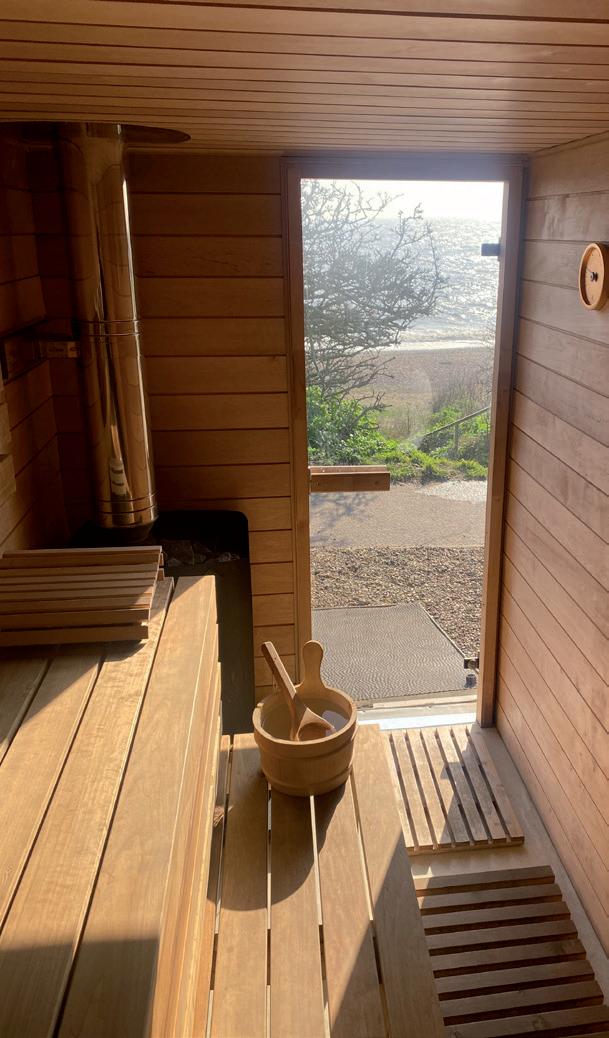
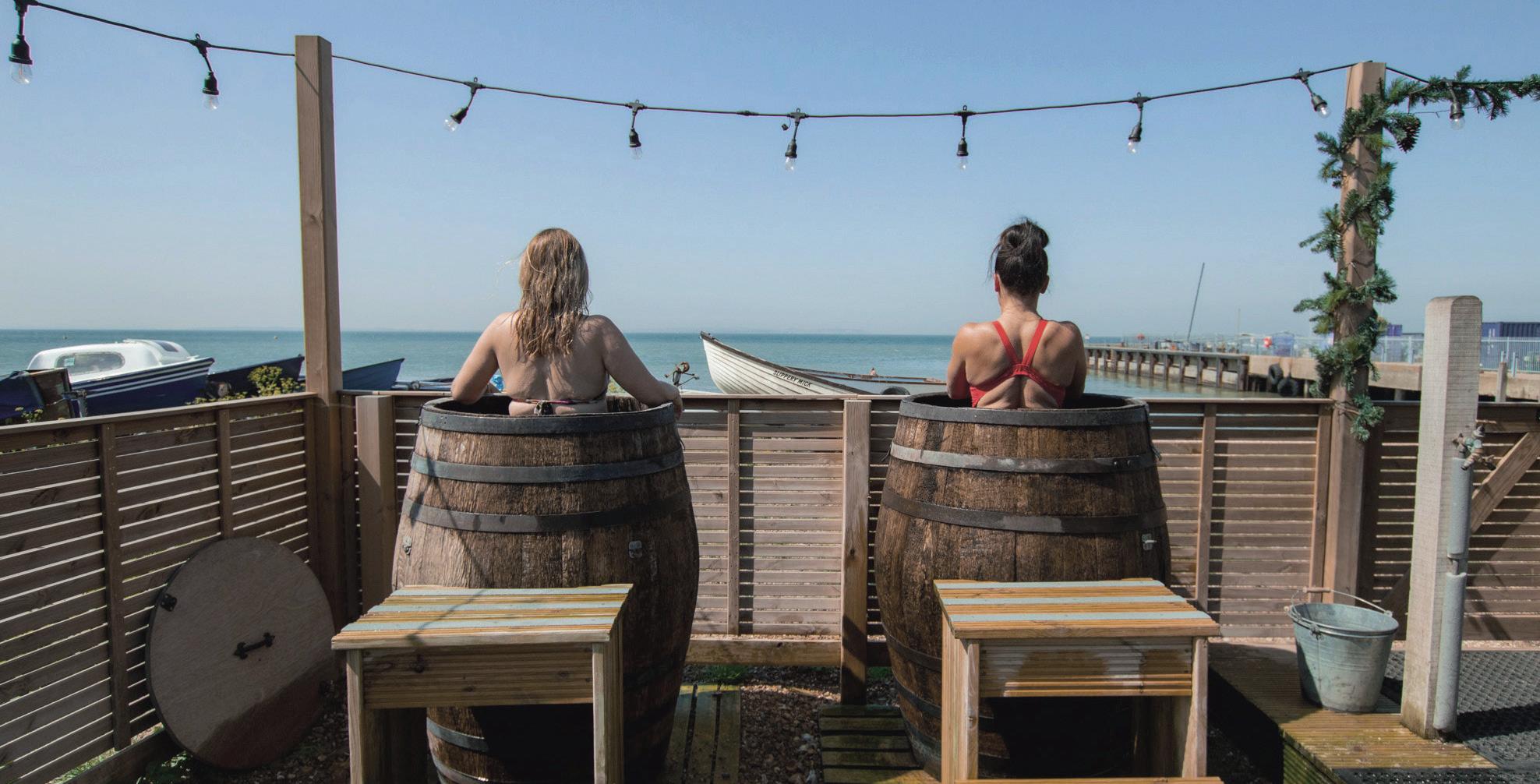
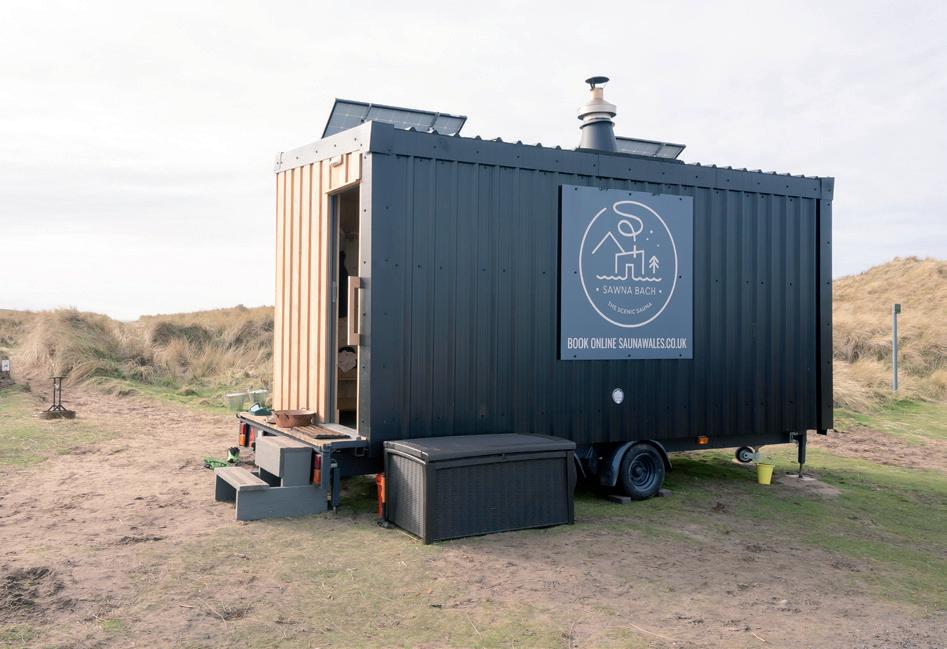
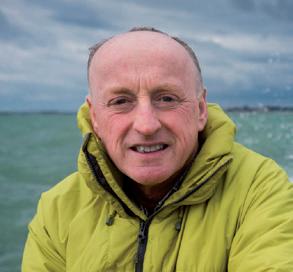
'As the increase in central blood volume is detected, hormones prompt our kidneys to produce urine from blood plasma … this can cause low blood pressure and "rewarming collapse"'
'The biggest concern, whatever the order, is that combining the two activities increases fluid loss and the viscosity (thickness) of our blood, and reduces the volume of blood circulating in our body. This can affect blood pressure and lead to fainting or circulatory problems.'
It’s easy to see that sweating in a sauna can lead to reduced blood volume and dehydration, but with coldwater dipping it’s more complicated. Mike explains: 'When we immerse ourselves in cold water, our body reduces blood flow to the skin to protect us against heat loss. As the increase in central blood volume is detected, hormones prompt our kidneys to produce urine from blood plasma – reducing the volume of blood. This is why you may need to urinate more when cold.
'This natural process is likely responsible for the accounts we’re hearing of lightheadedness and fainting when
people are sauna bathing. As we warm, blood flows back to the skin, but there now isn’t enough to maintain blood pressure. This can cause low blood pressure and "rewarming collapse". With a compromised cardiovascular system, the outcome can be serious.'
BETTER TOGETHER
We’re working with sauna operators to help make sauna bathing safer. Jen Holloway, Director of Sawna Bach in north Wales, says: 'We're passionate about safety and want to ensure we're providing our guests with the latest advice. We’ve learned that simple changes can save lives – such as not dunking your head for the first 2 minutes of a dip.
'We’ve also partnered with a local open water swimming coach to create a Safe-Sea Swimming and Sauna workshop. It’s designed for anyone new to sea swimming, those recovering from a difficult experience, or anyone wanting to build confidence and learn essential safety skills.'
Whitstable RNLI Crew Member Robin Bartlett co-founded Sea Scrub Sauna in Kent with his cousin Luke. Robin says: 'I've experienced how good cold water is for your physical and mental health, but also how easy it can be to cross the line.'
IMMERSION – NOT EXERCISE
It’s important to keep in mind that the aim is immersion, not exercise. Robin says: 'It’s hard to get into cold water, but it can become very easy to overstay your welcome –especially if you're enjoying the challenge. However, you get all the benefits within 2–3 minutes. It’s best to enjoy the dunk where it's safe and get out before you feel you have to. It's the experienced swimmers, used to staying in
When it isn't safe in the water, dip on land
Mike Tipton | Professor, University of Portsmouth
SAFETY TIPS FOR SAUNA BATHERS:
• Check you’re fit and healthy. At-risk groups include: children, older people, pregnant people, and those with pre-existing conditions, acute illness or temperature sensitivity.
• Before dipping, check the conditions and tide times. If they aren’t suitable, consider a land-based alternative.
• Start hydrated and stay hydrated.
• Don’t dip alone.
• Have a means of calling for help – call 999 or 112 in an emergency.
• If you get into difficulty in the water, Float to Live.
• Acclimatise slowly.
• Avoid submerging your face with extended breath holds.
• Stay within your depth.
• Understand how your body responds to the temperature extremes.
• Know the moments of increased risk in a sauna: changing position, standing – keep moving or contracting your leg muscles when seated.
• Recognise the signs that something’s wrong: thirst, lightheadedness, headache, disturbed vision, nausea, cramps, rapid heart rate, weakness, fatigue, loss of coordination.
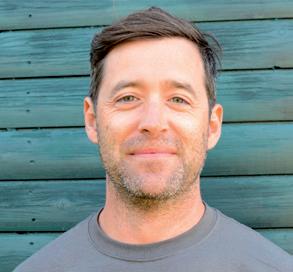
'It's the experienced swimmers, used to staying in cold water for longer, who we have to remind'
Robin Bartlett | Crew Member, Whitstable RNLI, Sauna Operator
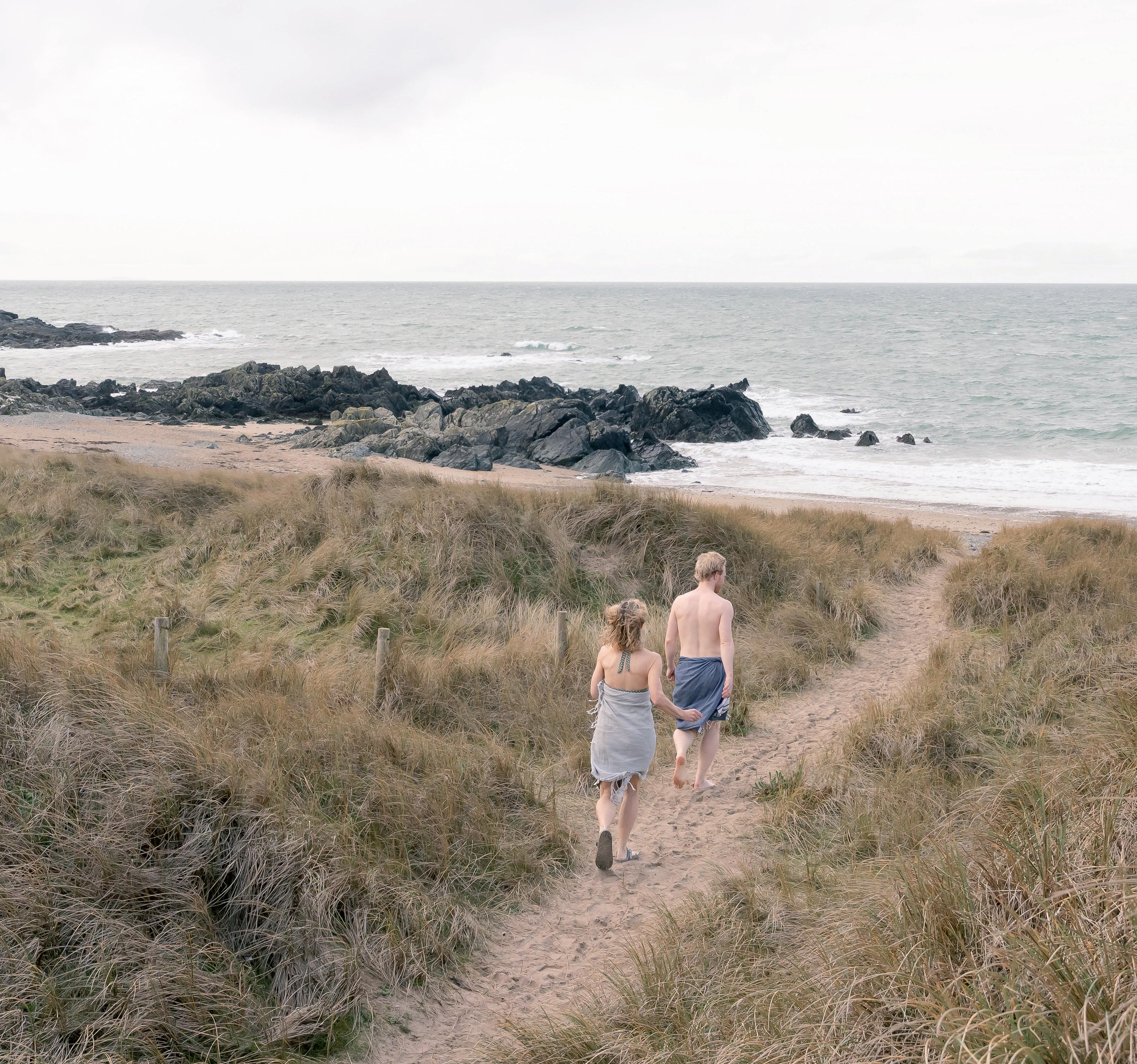
cold water for longer, who we have to remind – newbies get out pretty sharpish!'
Gabrielle Reason, Director of the British Sauna Society, says: 'We’re really grateful to the RNLI for contributing their expertise and wisdom. Good sauna doesn't exist without awareness of the safety risks, mitigation of them from sauna owners, and educated bathers who know how to get the best out of their experience.'
SHARE YOUR STORY
FIND OUT MORE
To read the research, along with safety tips for sauna operators, visit RNLI.org/research
Offshore is a space for sharing our experiences and increasing our knowledge. Do you have a story about a time things went wrong on the water, or news about ways you’re advancing water safety or watersports participation? If so, please email offshore@rnli.org.uk.
Words: dunnāco lee-morikū, Emmie Seward-Adams
Photos: Hannah Lockwood, Sawna Bach/Katherine Uxbridge, Sea Scrub Sauna, University of Portsmouth
HOW TO: CHECK YOUR ROPES
Fraying, hockling or melting?
Paul George and Ian Hansford from the RNLI All-weather Centre in Poole highlight the importance of rope and rigging checks
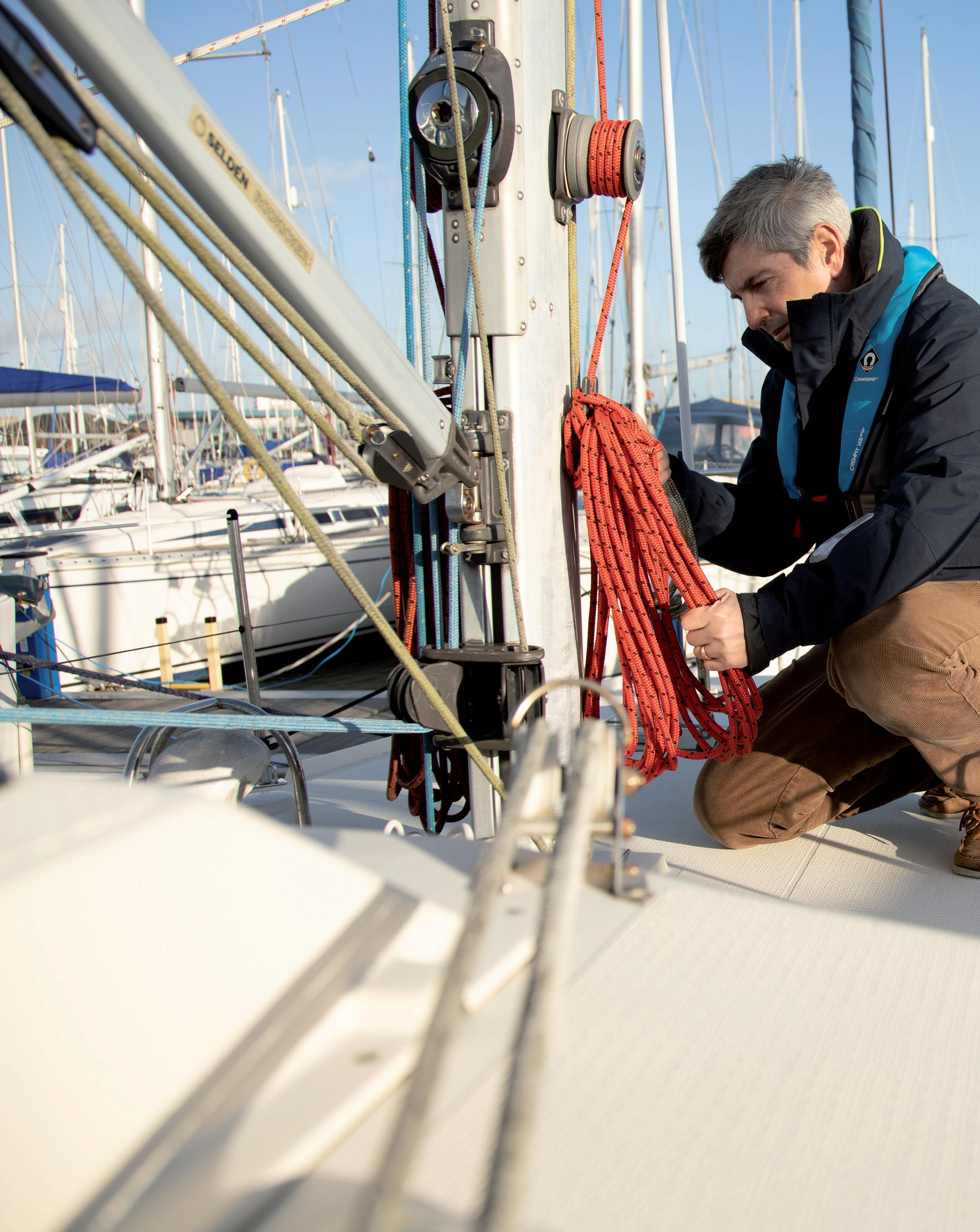
'It’s obvious really,’ says Ian. ‘All ropes should be checked every time they're used. If you don't check one when slack, it's highly likely to not work when under load.’
Rope checks on lifeboats can make the difference between life and death – for the crew and those we rescue. Paul says: ‘We inspect all the ropes on our lifeboats – mooring ropes, general purpose ropes, anchor cables and more. Plus the lifeboat stations do their own checks, as part of planned RNLI maintenance.’
For lifeboats in all weathers, the strain on ropes can be immense and if a rope parts under load, it can cause serious injury. ‘Training is key with rope and rigging maintenance,’ stresses Ian. ‘Plus all our crews are trained to never stand in the bite of a rope.’
Thankfully, not many leisure sailors would be out in extreme conditions if they can help it.
Paul says: ‘If your running or standing rigging hasn’t been checked, it’s more likely to fail when you need it most. And if your boat’s on a mooring, and you haven’t done your rope inspection after a sail, then your boat might not be there the next time you come to use it!’ There are regular lifeboat call outs for these scenarios.
Checking ropes before and after use might sound a bit excessive, but it can take as little as 5 minutes and it could make a big difference. A lot of it is simple visual checks. Opposite, Paul and the team highlight some areas you’ll want to pay a bit more attention to.
PAUL AND THE TEAM SHARE THEIR EXPERIENCE OF ROPES AND RIGGING, WITH FIVE TOP TIPS FOR SAFER BOATING


1 2 3 4 5
Ideally, buy your rope from marine outlets. Cheap blue packing rope from your local DIY store isn’t really fit for marine use. There are expensive technical ropes, but you can pick the right rope for the right job without breaking the bank. Nylons, basic polyesters and polypropylenes are popular.
Polypropylene rope will last well, as long as you inspect it and keep it out of the sunlight as much as you can. If possible, stow the rope inside. Inspect it by rubbing something (not your hand) across it. If the fibres start to break down, replace it. When it’s wet, give your rope a chance to dry off – ideally off the floor.
Ropes can melt when they surge around bollards, generating localised heat. Check before and after each use. You might spot that fibres are fused together and melted – therefore weakened.
DRAGS AND KNOTS
Don't drag ropes. Nylon ropes, which are good and very popular with good elasticity, are often very soft. If dragged, the strands catch very easily. Also be aware that using certain knots can weaken the rope, in some cases by up to 50%.
CATCH FRAYS
If your rope’s fraying, you’ll probably need to get it re-whipped. Do it sooner rather than later, so you can fix it before it all comes undone. THE RIGHT ROPE
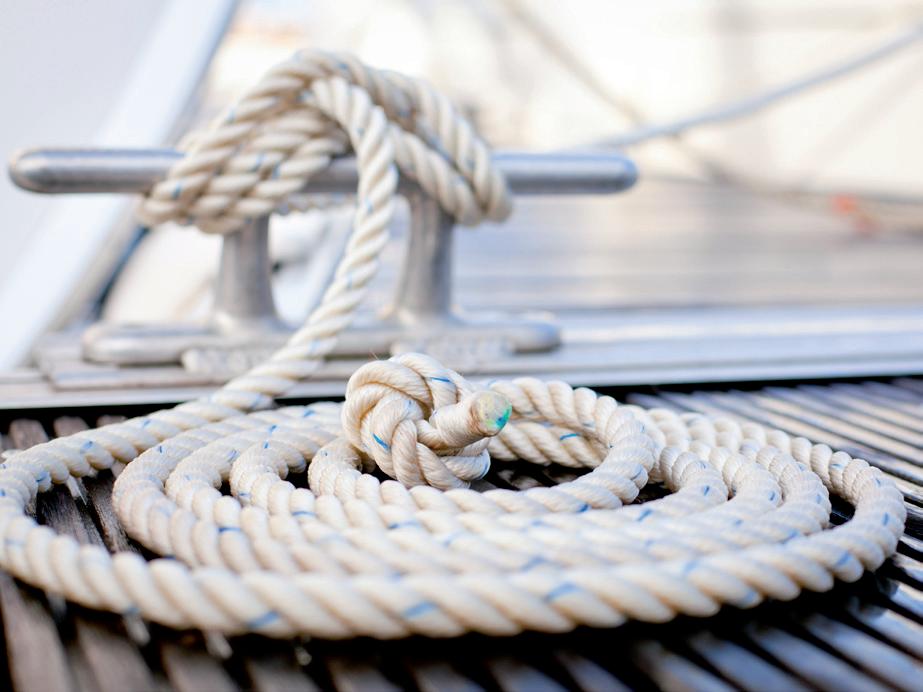


Avoid storing ropes on the floor
Use the right rope for the right job
WHAT WOULD YOU DO NEXT?
You’re sailing a 10m yacht alone when you are struck by the boom and suffer a head injury.
What do you do next?
RNLI ANSWER

JOEL NINNES
RNLI WATER SAFETY DELIVERY SUPPORT
At sea, things can quickly go wrong, so it’s crucial to be prepared. Two of the biggest dangers are complacency and forgetfulness. Should the skipper become incapacitated, the first thing to do is identify a second in command – they should know how to call for help and operate the engine. Of course, on solo journeys, that second in command is you! Being able to call for help (B) is key. At a minimum, carry a mobile phone in a waterproof pouch. However, there’s no guarantee of a phone signal when you’re offshore, so ideally you’ll have a VHF radio onboard. Having a basic understanding of how to use this is critical – crew should know how to use it too. All crew, but especially solo voyagers, should carry on them a personal locator beacon (PLB) –activating it will trigger an immediate reaction from the coastguard.
To learn more, visit RNLI.org/CallingForHelp
A Lower the anchor and rest until it’s safe to continue?
B Call 999 or 112 and ask the coastguard for help?
C Return to shore at a slow and steady speed?
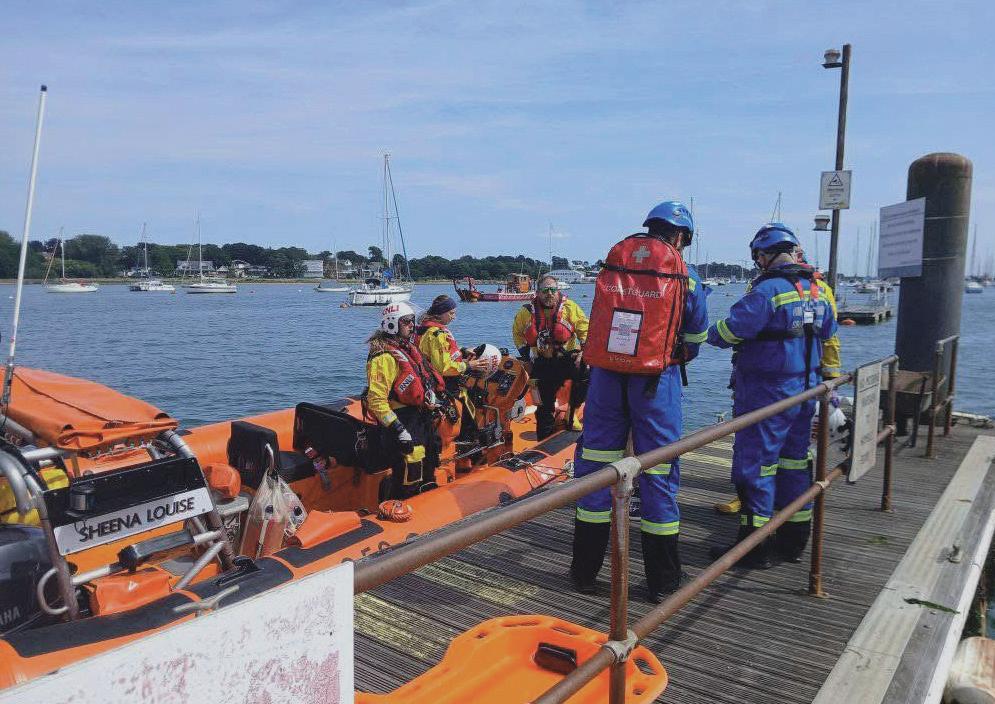
HEAD INJURY CAUSES RETHINK
When a lone sailor was injured by his yacht’s boom, he called HM Coastguard for help. Cowes RNLI’s inshore lifeboat crew launched, reaching the man in 5 minutes, and were joined by a Coastguard helicopter.
The crew gave casualty care to the sailor while a paramedic was winched from the helicopter onto the lifeboat, then transferred to the yacht. Despite suffering a broken nose, the casualty appeared not to be in immediate danger. So the RNLI volunteers transferred him to Hamble, where he was then cared for by a Coastguard Rescue Team and ambulance crew.
RNLI CALL OUTS TO INJURED OR ILL MOTORBOATERS AND SAILORS IN 2024
Libby Finch, Cowes RNLI Helm, said: ‘We were happy to be able to help today. He did the right thing in calling for help as soon as he was injured. When going sailing, always carry a means of calling for help. If in trouble, dial 999 or 112 and ask for the coastguard.’ ■
Photos: RNLI/Paul Cobbett
The Cowes RNLI crew delivered the sailor into the care of the Hill Head Coastguard Rescue Team w
